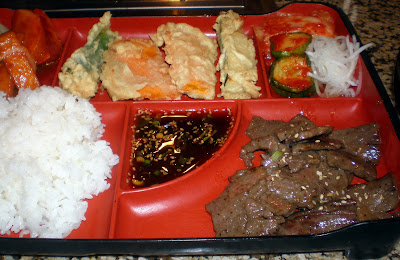A distant vague memory: As a food, I thought jellyfish was exotic.
In 1994, I went to a Chinese buffet in the Rice Village. Good Chinese buffets are rare, but this one had high quality and some not-so-Americanized dishes. (I believe the name may have been China Station, and I know the restaurant is long departed).
A jellyfish appetizer had many flavors -- pungency, sweetness, nuttiness. Yet I wasn't completely sure which part of the dish was the jellyfish.
Last week: In Hong Kong Market, a stand displayed three brands of salted jellyfish. One cost around $1.50. Another, $2.50. The third, $3.50.
In an Asian grocery, when I don't know the product, and the packaging is not English, I follow a simple rule: Buy the most expensive one. I did.
Salted jellyfish requires a little preparation and a lot of waiting. First, you boil the thin strips in water with a little vinegar until they just begin to shrink. Then, you let them rest in cold water - to get out the salt. I waited a full day.
The reality. As I pulled the prepared jellyfish from the refrigerator, I discovered that jellyfish, as food, are not strange. After the salt has leached out, they have little flavor. Instead they become pasta-like conduits of other flavors.
As I contemplated what to do with these bland, slimy strands, I remembered Vietnamese salads with glass noodles. Like glass noodles, jellyfish have a slightly slimy, slightly chewy/crunchy texture.
So the dish began to appear in my head: a Vietnamese salad with jellyfish instead of glass noodles:
 The base consists of shredded carrots, shredded cucumber, and jellyfish mixed with a combination of fish sauce, lime juice, sugar, crushed peanuts, chili pepper, and sesame seeds. To make it a meal, I topped it with strips of egg omelet, grilled chicken, and mint.
The base consists of shredded carrots, shredded cucumber, and jellyfish mixed with a combination of fish sauce, lime juice, sugar, crushed peanuts, chili pepper, and sesame seeds. To make it a meal, I topped it with strips of egg omelet, grilled chicken, and mint.(In the photo, the bits of jellyfish are the translucent strips mixed in with carrots.)
A new understanding of jellyfish. As food, jellyfish is immensely utilitarian. It acts as a texture base and a platform for other flavors. But unlike pasta, it is high in protein, low in calories, low in carbs, low in fat.
It is only as exotic -- and only as good -- as the ingredients, flavors, and imagination that you add.



 I asked him to describe it. "It's good," he said. "Care to add anything else?" I asked. "Nope."
I asked him to describe it. "It's good," he said. "Care to add anything else?" I asked. "Nope." For days, I have had a spring in my step. Now I know that great Vietnamese food is back inside the Loop -- or maybe it never left.
For days, I have had a spring in my step. Now I know that great Vietnamese food is back inside the Loop -- or maybe it never left.
















